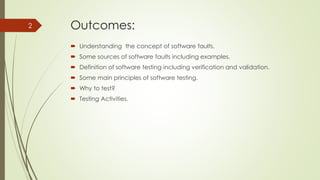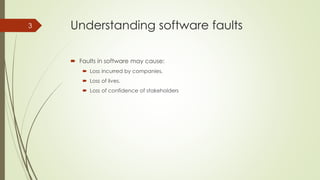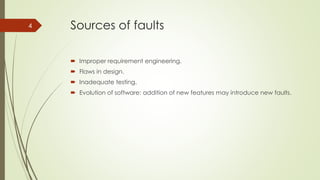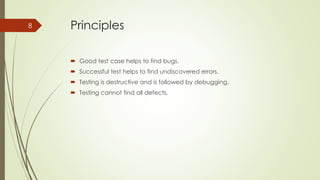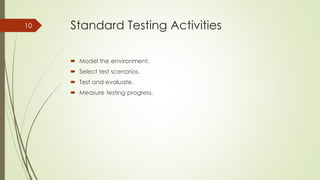Introduction to software testing
- 1. Software Testing & Quality 1 Assurance Lecture 1 Introduction to software testing
- 2. 2 Outcomes: ’é┤ Understanding the concept of software faults. ’é┤ Some sources of software faults including examples. ’é┤ Definition of software testing including verification and validation. ’é┤ Some main principles of software testing. ’é┤ Why to test? ’é┤ Testing Activities.
- 3. 3 Understanding software faults ’é┤ Faults in software may cause: ’é┤ Loss incurred by companies. ’é┤ Loss of lives. ’é┤ Loss of confidence of stakeholders
- 4. 4 Sources of faults ’é┤ Improper requirement engineering. ’é┤ Flaws in design. ’é┤ Inadequate testing. ’é┤ Evolution of software: addition of new features may introduce new faults.
- 5. 5 Software Testing ’é┤ A process or set of activities to prove quality of software to stakeholders. ’é┤ Verification and validation is part of testing.
- 6. 6 Verification(product right) X SOFTWARE X FUNCTIONALITY
- 7. 7 Validation (Right product) ’é┤ Making sure software provide traceable requirements.
- 8. 8 Principles ’é┤ Good test case helps to find bugs. ’é┤ Successful test helps to find undiscovered errors. ’é┤ Testing is destructive and is followed by debugging. ’é┤ Testing cannot find all defects.
- 9. 9 Testing & confidence ’é┤ Increase % bugs found, the higher is the confidence.
- 10. 10 Standard Testing Activities ’é┤ Model the environment. ’é┤ Select test scenarios. ’é┤ Test and evaluate. ’é┤ Measure testing progress.


